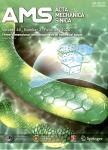Stability and oscillations in a slow-fast flexible joint system with transformation delay
Stability and oscillations in a slow-fast flexible joint system with transformation delay作者机构:School of Aerospace Engineering and Applied MechanicsTongji University
出 版 物:《Acta Mechanica Sinica》 (力学学报(英文版))
年 卷 期:2014年第30卷第5期
页 面:727-738页
核心收录:
学科分类:080202[工学-机械电子工程] 08[工学] 0804[工学-仪器科学与技术] 0827[工学-核科学与技术] 082701[工学-核能科学与工程] 0802[工学-机械工程]
基 金:supported by the National Natural Science Foundation of China(11032009 and 11272236)
主 题:Flexible joint - Slow-fast system - Transforma- tion delay Geometric singular perturbation
摘 要:Flexible joints are usually used to transfer velocities in robot systems and may lead to delays in motion transformation due to joint flexibility. In this paper, a linkrotor structure connected by a flexible joint or shaft is firstly modeled to be a slow-fast delayed system when moment of inertia of the lightweight link is far less than that of the heavy rotor. To analyze the stability and oscillations of the slowfast system, the geometric singular perturbation method is extended, with both slow and fast manifolds expressed analytically. The stability of the slow manifold is investigated and critical boundaries are obtained to divide the stable and the unstable regions. To study effects of the transformation delay on the stability and oscillations of the link, two quantitatively different driving forces derived from the negative feedback of the link are considered. The results show that one of these two typical driving forces may drive the link to exhibit a stable state and the other kind of driving force may induce a relaxation oscillation for a very small delay. However, the link loses stability and undergoes regular periodic and bursting oscillation when the transformation delay is large. Basically, a very small delay does not affect the stability of the slow manifold but a large delay affects substantially.



